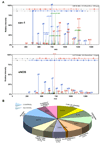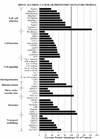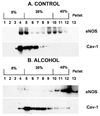High-throughput caveolar proteomic signature profile for maternal binge alcohol consumption - PubMed (original) (raw)
High-throughput caveolar proteomic signature profile for maternal binge alcohol consumption
Jayanth Ramadoss et al. Alcohol. 2010 Nov-Dec.
Abstract
Currently, no single marker is sensitive and specific enough to be considered a reliable biomarker for prenatal alcohol exposure. To identify a proteomic signature profile for maternal alcohol consumption, we carried out high-throughput proteomics on maternal endothelial caveolae exposed to moderate binge-like alcohol conditions. In these specialized lipid-ordered microdomains that contain a rich assembly of proteins, we demonstrate that moderate binge-like alcohol resulted in a distinctive maternal caveolar proteomic signature with important proteins being dramatically decreased/knocked out in the alcoholic profile. These proteins span from histones and basic structural proteins like α tubulin to proteins involved in trafficking, deubiquitination, cell signaling, and cell-cell adhesion. The profile also suggests an important role for the mother and the uteroplacental compartment in the pathogenesis of fetal alcohol spectrum disorders (FASD). These data demonstrate that the caveolar proteomic signature created by alcohol shows a promising direction for early detection of FASD.
Copyright © 2010 Elsevier Inc. All rights reserved.
Figures
Figure 1
(A) Representative MS/MS spectra of cav-1 and eNOS illustrate a nearly complete Y ion series assignment. The B ion series confirm peptide assignment. All major signals in the spectra are explained by the assigned sequences. Sequest cross correlation scores for cav-1 and eNOS are 4.58 and 4.08 respectively. Cav-1 and eNOS parent mass error are −0.39 PPM and −1.8 PPM respectively. (B) Chronic binge-like alcohol exposure resulted in dramatic decreases in the abundance of endothelial caveolar proteins related to cell-cell adhesion, cell function, cell signaling, deubiquitination, histones, nitric oxide/vascular tone, structure, and transport/trafficking. Pie chart slices bound by solid lines represent the caveolar protein abundance in control state. The shaded subset in each slice represents the caveolar protein abundance in response to chronic binge alcohol.
Figure 2
Chronic binge-like alcohol exposure resulted in a distinctive endothelial caveolar proteomic signature profile that included proteins related to cell-cell adhesion, cell function, cell signaling, deubiquitination, histones, nitric oxide/vascular tone, structure, and transport/trafficking. Profile details and abbreviations are described in the Results section. The caveolar protein profile is depicted as % of control.
Figure 3
Western immunoblot analysis of gradient density centrifugation of subcellular fractions fractions prepared from (A) control (0 mg/dl) and (B) binge alcohol (150 mg/dl) treated uterine arterial endothelial cells from pregnant ewes. Under control conditions, cav-1 and eNOS were both predominantly located in the caveolar pool (lanes 4–5; figure 2A) whereas endothelial nitric oxide synthase was entirely depleted from this caveolar pool in response to binge-like alcohol (figure 2B).
Similar articles
- 2-D DIGE uterine endothelial proteomic profile for maternal chronic binge-like alcohol exposure.
Ramadoss J, Magness RR. Ramadoss J, et al. J Proteomics. 2011 Nov 18;74(12):2986-94. doi: 10.1016/j.jprot.2011.07.029. Epub 2011 Aug 4. J Proteomics. 2011. PMID: 21839868 Free PMC article. - Maternal choline supplementation mitigates alcohol-induced fetal cranio-facial abnormalities detected using an ultrasonographic examination in a sheep model.
Sawant OB, Birch SM, Goodlett CR, Cudd TA, Washburn SE. Sawant OB, et al. Alcohol. 2019 Dec;81:31-38. doi: 10.1016/j.alcohol.2019.05.001. Epub 2019 May 10. Alcohol. 2019. PMID: 31082506 Free PMC article. - Epigallocatechin Gallate Ameliorates the Effects of Prenatal Alcohol Exposure in a Fetal Alcohol Spectrum Disorder-Like Mouse Model.
Almeida-Toledano L, Andreu-Fernández V, Aras-López R, García-Algar Ó, Martínez L, Gómez-Roig MD. Almeida-Toledano L, et al. Int J Mol Sci. 2021 Jan 13;22(2):715. doi: 10.3390/ijms22020715. Int J Mol Sci. 2021. PMID: 33450816 Free PMC article. - Long-term alterations to DNA methylation as a biomarker of prenatal alcohol exposure: From mouse models to human children with fetal alcohol spectrum disorders.
Laufer BI, Chater-Diehl EJ, Kapalanga J, Singh SM. Laufer BI, et al. Alcohol. 2017 May;60:67-75. doi: 10.1016/j.alcohol.2016.11.009. Epub 2016 Nov 22. Alcohol. 2017. PMID: 28187949 Review. - Ocular involvement in fetal alcohol spectrum disorder: a review.
Brennan D, Giles S. Brennan D, et al. Curr Pharm Des. 2014;20(34):5377-87. doi: 10.2174/1381612820666140205144114. Curr Pharm Des. 2014. PMID: 24502600 Review.
Cited by
- Interactive effects of in vitro binge-like alcohol and ATP on umbilical endothelial nitric oxide synthase post-translational modifications and redox modulation.
Subramanian K, Naik VD, Sathishkumar K, Sawant OB, Washburn SE, Wu G, Yallampalli C, Saade GR, Hankins GD, Ramadoss J. Subramanian K, et al. Reprod Toxicol. 2014 Jan;43:94-101. doi: 10.1016/j.reprotox.2013.11.006. Epub 2013 Dec 1. Reprod Toxicol. 2014. PMID: 24300283 Free PMC article. - Epigenetic Mechanisms in Developmental Alcohol-Induced Neurobehavioral Deficits.
Basavarajappa BS, Subbanna S. Basavarajappa BS, et al. Brain Sci. 2016 Apr 8;6(2):12. doi: 10.3390/brainsci6020012. Brain Sci. 2016. PMID: 27070644 Free PMC article. Review. - A comparison of the different animal models of fetal alcohol spectrum disorders and their use in studying complex behaviors.
Patten AR, Fontaine CJ, Christie BR. Patten AR, et al. Front Pediatr. 2014 Sep 3;2:93. doi: 10.3389/fped.2014.00093. eCollection 2014. Front Pediatr. 2014. PMID: 25232537 Free PMC article. Review. - Epigenetics studies of fetal alcohol spectrum disorder: where are we now?
Lussier AA, Weinberg J, Kobor MS. Lussier AA, et al. Epigenomics. 2017 Mar;9(3):291-311. doi: 10.2217/epi-2016-0163. Epub 2017 Feb 17. Epigenomics. 2017. PMID: 28234026 Free PMC article. Review. - Alcohol-induced alterations in maternal uterine endothelial proteome: a quantitative iTRAQ mass spectrometric approach.
Ramadoss J, Magness RR. Ramadoss J, et al. Reprod Toxicol. 2012 Dec;34(4):538-44. doi: 10.1016/j.reprotox.2012.08.008. Epub 2012 Sep 5. Reprod Toxicol. 2012. PMID: 22960358 Free PMC article.
References
- Bird IM, Sullivan JA, Di T, Cale JM, Zhang L, Zheng J, Magness RR. Pregnancy-dependent changes in cell signaling underlie changes in differential control of vasodilator production in uterine artery endothelial cells. Endocrinology. 2000;141:1107–1117. - PubMed
- Bird IM, Zhang L, Magness RR. Possible mechanisms underlying pregnancy-induced changes in uterine artery endothelial function. Am. J. Physiol. Regul. Integr. Comp. Physiol. 2003;284:R245–R258. - PubMed
- Bonthius DJ, Karacay B, Dai D, Pantazis NJ. FGF-2, NGF and IGF-1, but not BDNF, utilize a nitric oxide pathway to signal neurotrophic and neuroprotective effects against alcohol toxicity in cerebellar granule cell cultures. Brain Res. Dev. Brain Res. 2003;140:15–28. - PubMed
MeSH terms
Substances
Grants and funding
- R01 HL049210/HL/NHLBI NIH HHS/United States
- K99 AA019446/AA/NIAAA NIH HHS/United States
- P01 HD038843/HD/NICHD NIH HHS/United States
- R01 HL070562/HL/NHLBI NIH HHS/United States
- R01 HL087144/HL/NHLBI NIH HHS/United States


